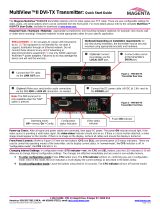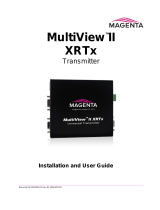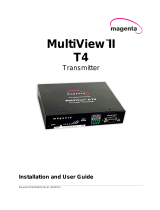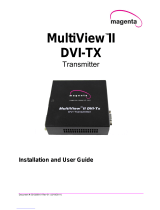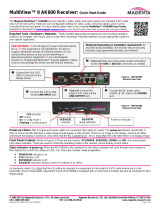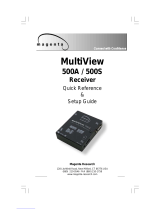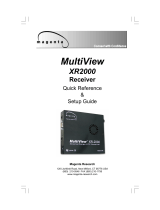Page is loading ...

MultiView™ II XRTx Transmitter: Quick Start Guide
© 2014 tvONE, 2791 Circleport Drive, Erlanger KY 41018 USA
Americas: 859-282-7303, EMEA: +44 (0)1843 873322, email: [email protected]m www.tvone.com
Document # CSG-MULTIVIEW-XRTX Rev-01 (15-Jan-2015) Page 1 of 3
The Magenta MultiView™ II XRTx transmitter extends an analog video signal over FTP CAT5 cable (also CAT5e and CAT6). There
are user-configurable settings for video, audio, and serial options which can be controlled from the front panel. For more details please
refer to the complete MultiView™ II XRTx User Guide, available for download at www.tvone.com.
Required Tools / Hardware / Materials: Tools include appropriate screwdriver(s) and mounting hardware (optional, for
example: rack-mount, wall or under-desk mounting). Required materials include appropriate cables for your specific application.
Power-up Check: After all signal and power cables are connected, apply AC power. The power ON indicator should light. If the
video source is providing a valid VGA (RGB+HV) video signal, the video-status indicator should also be on (for any other type of video
signal this status indicator will always be off). If there is a local monitor attached, a video image should appear on the monitor. If there is
no image on the display, recheck all cables and ensure the display is turned on.
Front Panel Controls: (Refer to Figure 2) There are two buttons (COPY/CFG and DDC MODE/SEL), and several green LED status
indicators. These are used to control the operating modes of the transmitter, and to display current status. In “normal-mode”, the CFG
indicator is off. In “configuration-mode”, the CFG indicator is on or flashing.
DDC Mode Selection: When the XRTx is operating in normal-mode (CFG indicator is off), it is possible to quickly select between
the 3 DDC operating modes simply by using the DDC MODE button at any time:
STD: Selects the Magenta Magic DDC profile. Press the DDC MODE button until the STD indicator (LED 6) is on. The
Magenta Magic profile is a default set of common video resolutions. This is the factory default setting.
LOCAL: Selects the DDC profile from a locally-connected display. Press the DDC MODE button until the LOCAL
indicator (LED 7) is on. The LOCAL mode allows the video source device to directly read the DDC profile from the locally
connected-display (if present). Note that LOCAL mode does not store any DDC profile information inside the XRTx device.
COPY: Selects a previously stored copy of a DDC profile. Press the DDC MODE button until the COPY indicator (LED 8)
is on. To use the COPY mode, a DDC profile must have already been read and stored into the XRTx.
To perform a DDC-copy operation: Ensure the COPY mode is selected (LED 8=on), then: (1) Connect a display to the
LOCAL OUT port. (2) Push and hold the COPY button until the copy-status indicator flashes 3 times, indicating a successful
operation. If it only flashes once, the operation failed and the previously stored DDC profile (if any) will remain unchanged.
Figure 1 - XRTx
Transmitter Rear View
(Optional) Depending on installation requirements: At
any time during installation, the transmitter may be securely
mounted using appropriate brackets and hardware.
PRECAUTIONS: (1) Do not apply AC power until instructed to
do so. (2) This equipment is not intended for, nor does it
support, distribution through an Ethernet network. Do not
connect these devices to any sort of networking or
telecommunications equipment! (3) Use only tvONE-approved
MultiView™ II power adapters. Failure to do so may damage
this device and will void the warranty.
Figure 2 - XRTx
Transmitter Front View
Note: The DB9 serial port is
only available when the “232”,
“SA” or “SAP” option is present.
Connect the CAT5 cable
via the LINK OUT port.
(Optional) Connect
local display via the
LOCAL OUT port.
Connect video source
to the transmitter’s
VGA IN port.
(Optional) Make your serial and/or audio connections
via the DB9 IOIO or AUX I/O connectors, as needed.
Connect the DC power cable (+5VDC @ 2.6A. max) to
the POWER port.
Power-on indicator
Video-status and
DDC-copy indicator
Operating mode:
Off = normal, On = Config

© 2014 tvONE, 2791 Circleport Drive, Erlanger KY 41018 USA
Americas: 859-282-7303, EMEA: +44 (0)1843 873322, email: [email protected]m www.tvone.com
Document # CSG-MULTIVIEW-XRTX Rev-01 (15-Jan-2015) Page 2 of 3
Changing Internal Settings: In configuration-mode (CFG indicator = on or flashing), the CFG and SEL buttons, plus the LED
indicators (1-8) will allow you to change internal configuration settings. The changes are effective immediately and are saved in non-
volatile memory.
To enter configuration-mode-1: Press CFG button once. The CFG indicator will turn on, confirming you’re in configuration-
mode-1. Once in this mode, the LED indicators 1-8 will display the current settings as described in the tables below.
To enter configuration-mode-2: Press CFG button twice. The CFG indicator will flash, confirming you’re in configuration-
mode-2. Once in this mode, the LED indicators 1-8 will display the current settings as described in the tables below.
To exit configuration-mode: Leave the buttons untouched for 10 seconds. The CFG indicator will turn off (normal-mode).
Configuration Mode-1, Sync-mode Options: The XRTx is factory-configured for auto-detecting the proper sync-mode
(RepliSync-I normal/stretched). This mode is generally compatible with all existing MultiView receiver products that support RepliSync
(if they are also using their default settings). However, some video sources may require a custom sync-mode setting (especially at
1080p and 1920x1200 video resolutions). For these cases, one of the other sync-modes can be selected. Note that any connected
MultiView receiver MAY also require a change to its sync-mode settings. Otherwise, you may not get a proper video display output at
that receiver.
(starting in normal-mode) Press and release the CFG button once to access configuration-mode-1. CFG indicator = on.
Press and release the SEL button once. You will now be able to change sync-mode settings.
LED indicators 1-3 should be illuminated (either DIM or ON); all others (indicators 4-8) should be off.
Press the CFG button repeatedly to step through the available sync-mode settings as shown below.
To leave configuration-mode step through all the options OR leave the buttons untouched for 10 seconds.
LED1
LED2
LED3
Front Panel View
Sync-mode Setting
dim
dim
dim
The XRTx will auto-detect the required RepliSync-I mode (“normal” or
“stretched”). This is the factory-default setting.
dim
dim
ON
Force RepliSync-I normal Horizontal sync. pulse encoding.
dim
ON
dim
Force RepliSync-I “stretched” Horizontal sync. pulse encoding.
dim
ON
ON
Force RepliSync-II.
ON
dim
dim
Force fixed-sync mode. NOTE: A connected MultiView receiver must also be in
fixed-sync mode and with H/V polarities selected at the receiver.
Configuration Mode-1, 4
th
Pair Options: The XRTx provides several options for using the 4
th
-pair signals (pairs 1-3 are generally
used for video). The factory-default settings support analog audio (L+R summed) on the 4
th
-pair. Note that any connected MultiView
receiver must be configured with a matching 4
th
-pair operating mode. Otherwise, the desired 4
th
-pair signal will not work as expected.
Note: If an optional daughterboard is installed (232, SA or SAP options), then the 4
th
-pair utilization is defined by the installed
daughterboard. It will not be possible to change any of the 4
th
-pair settings as described below.
(starting in normal-mode) Press and release the CFG button once to access configuration-mode-1. CFG indicator = on.
Press and release the SEL button twice. You will now be able to change 4
th
-pair option settings.
LED indicators 4-6 should be illuminated (either DIM or ON); all others (indicators 1-3, 7 and 8) should be off.
Press the CFG button repeatedly to step through the available 4
th
-pair settings as shown below.
To leave configuration-mode step through all the options OR leave the buttons untouched for 10 seconds.
LED4
LED5
LED6
Front Panel View
4
th
-pair Operating Mode
Note: If an optional daughterboard is installed these cannot be changed.
dim
dim
dim
If option-module is installed: 4
th
-pair operating mode is defined by the presence
of the option-module (232/SA/SAP) and this setting cannot be changed
If the option-module is not installed: 4
th
-pair signals are disabled. This effectively
“mutes” anything being sent on the 4
th
pair. This can be useful for diagnostic
purposes.
dim
dim
ON
Direct pass-through of 4
th
-pair wires (custom applications).
dim
ON
dim
External analog (L+R summed) audio. This is the factory-default mode if no
daughterboard option is installed.
dim
ON
ON
External S/PDIF digital audio. Input-impedance = 75-ohms.
ON
dim
dim
Simplex-serial.

© 2014 tvONE, 2791 Circleport Drive, Erlanger KY 41018 USA
Americas: 859-282-7303, EMEA: +44 (0)1843 873322, email: [email protected]m www.tvone.com
Document # CSG-MULTIVIEW-XRTX Rev-01 (15-Jan-2015) Page 3 of 3
Configuration Mode-2, Video Coupling: Select AC or DC coupling, and DC-restore functions, to be applied to the input video.
(starting in normal-mode) Press and release the CFG button twice to access configuration-mode-2. CFG indicator = flashing.
Press and release the SEL button once. You will now be able to change video-coupling settings.
LED indicators 1-2 should be illuminated (either DIM or ON); all others (indicators 3-8) should be off.
Press the CFG button repeatedly to step through the available video-option settings as shown below.
To leave configuration-mode step through all the options OR leave the buttons untouched for 10 seconds.
LED1
LED2
Front Panel View
Video Options Mode
dim
dim
Auto-detect AC/DC coupling mode based on input signal.
This is the factory-default mode.
dim
ON
Video-input is DC coupled.
ON
dim
Video-input is AC coupled, no DC-restore function.
ON
ON
Video-input is AC coupled, DC-restore function enabled.
Configuration Mode-2, Video Termination: Select input video termination to be 75 ohms or high-impedance (Hi-Z).
(starting in normal-mode) Press and release the CFG button twice to access configuration-mode-2. CFG indicator = flashing.
Press and release the SEL button twice. You will now be able to change video-termination settings.
LED indicator 3 should be illuminated (either DIM or ON); all others (indicators 1, 2, 4-8) should be off.
Press the CFG button repeatedly to toggle video termination on/off, as shown below.
To leave configuration-mode step through all the options OR leave the buttons untouched for 10 seconds.
LED3
Front Panel View
Video Options Mode
dim
Video input impedance is Hi-Z.
ON
Video-input impedance is 75-ohms. This is the factory-default setting.
To reset all user-configurable options back to factory-default settings:
Disconnect the DC power cable (or AC power).
Press and hold the CFG button.
Connect the DC power cable (or AC power). All LEDs blink 3 times – all settings are now changed back to factory-defaults.
Release the CFG button.
Troubleshooting: In many cases, problems encountered when installing MultiView™ II extension products can be resolved by
checking the CAT5 cable termination. It must be pinned out according to the TIA/EIA 568B standard wiring specification. For additional
troubleshooting information or to obtain the TIA/EIA 568B wiring specifications please refer to the MVII-XRTx User Guide,
downloadable from www.tvone.com
/
